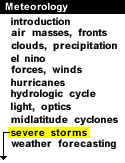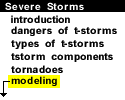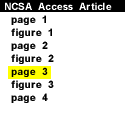
|
 |
|||
| What sets ARPS apart is that it continually ingests data
fine enough to capture essential storm details. Just as a checkbook's ending
balance cannot be right if the starting balance is wrong, a forecast cannot
be right if it starts with incomplete data. The starting balance for ARPS
comes from geostationary satellites, ground-based observing systems, and
the National Weather Services' new
NEXRAD
Doppler radar network.
Distinctive, with a globe perched atop a scaffoldlike structure, Doppler radars record wind speed and direction -- essential for predicting how a storm will form and evolve -- every five minutes at 1-km spatial intervals throughout the 11 to 13 layers of the troposphere -- the 10 vertical miles that constitute the weather-producing portion of the atmosphere. The Weather Service installed the last of its 123 Doppler radars last summer, which are being tied in with another 23 Doppler radars at sites operated by the Department of Defense and the Federal Aviation Administration. The NEXRAD data are usually "thinned" to four layers before being transmitted to Weather Service headquarters in Silver Springs, MD, and on to weather reporting stations and commercial vendors. This thinning helps avoid network overloads but eliminates details. Droegemeier's center, however, receives the full-volume NEXRAD datastream from eight radars in the southern Great Plains through a project funded by the Oklahoma State Regents for Higher Education that uses an advanced statewide network called OneNet. The center's researchers were the first to devise a means for using these data in real time for storm predictions, and now ARPS runs daily. The center's researchers also developed techniques for retrieving the 3D dynamics of a storm from 1D data. Doppler radar measures wind motion parallel to the radar beam, which is only one dimension of the wind. "Think of this radial wind component as north-south," explains Droegemeier. "You also need east-west and up-down wind." Weather prediction models calculate about a dozen other variables, such as temperature, pressure, and moisture fields. The computational demands of digesting 1.5 gigabytes of Doppler data and then calculating these variables explains why Droegemeier's team needed all 128 nodes of NCSA's Origin2000 to run their model in real time. Earlier versions of ARPS were run on different supercomputers at the Pittsburgh Supercomputing Center. (ARPS was written to run efficiently on any parallel computer.) |
|||
 Generating
10 daily forecasts for 7 days straight required: Generating
10 daily forecasts for 7 days straight required:
|
|||

figure 2 |
|

figure 3 |







